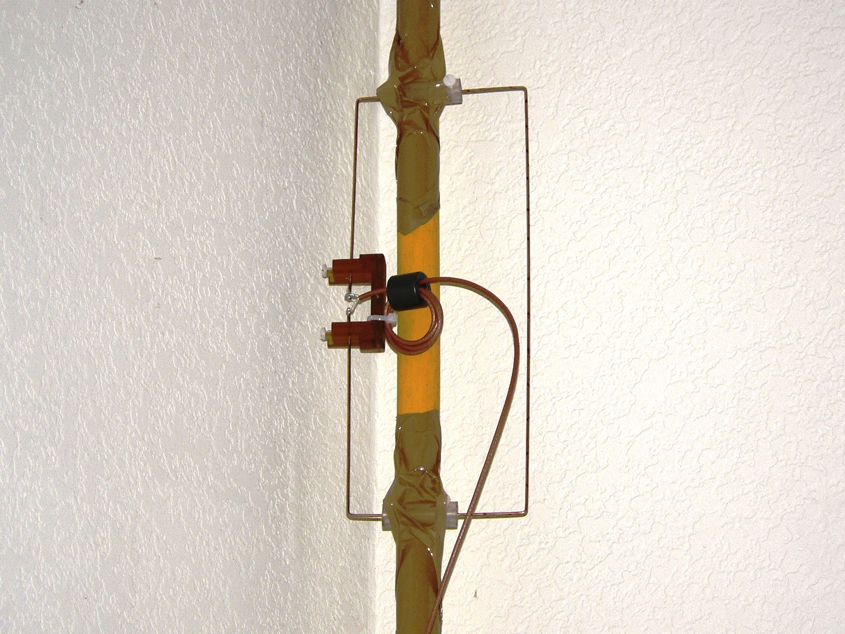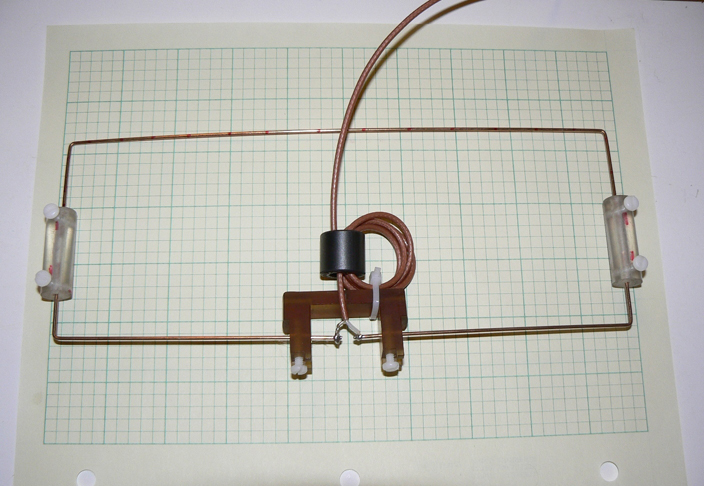KI6SZK'S UHF BROOMSTICK MOXON
Ed Davies, KI6SZK, recently sent in this excellent piece about his UHF design. Proof once again that no two moxons are identical--ed
I am newly licensed and an apartment dweller (San Jose,CA), so I have limited recourse when erecting radiating structures. I stumbled across this site while looking for “easy and cheap” antennas (#1 and #2 priorities). I read through the site and downloaded the design program, then spent an evening building one for the 70cm FM sub-band out of my scrap pile and junk box. I used scrap .060” copper rod for the elements and cut polystyrene rod for the end gap insulators. I also happened to have a scrap piece of low loss ULTEM material for the feed insulator. The feed line came from the junk box and is some sort of low loss version of RG-174 type coax salvaged from somewhere with a BNC connector on one end. I also used a salvaged NiZn mix RF suppression core for the 1:1 balun to protect against feed line radiation. I took care in measuring and bending, as well as keeping the whole thing as straight as possible (picture 1).

Wanting to test it immediately, I taped it to a broom handle and propped it up on a bookshelf in a corner of the living room facing NNW (pictures 2,3). The feed line was ~20’ of salvaged RG-400 type coax, as well as the short length of RG-174 type coax attached to the antenna itself, along with several coax connectors and adapters to my Yaesu FT-60 handheld. I am on the third floor of my complex (top floor) but have a screen of trees and intervening buildings in the near field. In spite of this, I was able to key up a repeated 50+ miles away in San Rafael, CA. I was able to do so even with 500mW. Signals were strong and clear both ways even at low power. At 10mW per mile on two pieces of bent copper rod propped up in the corner, through an RF obstacle course of trees and buildings? I am a believer!
I have no way of accurately measuring the performance of this antenna quantitatively, but as for qualitative performance it is a winner. I was unaffected by strong local repeaters on adjacent frequencies located on the backside of the antenna pattern and VSWR is <1.2:1 across the entire 440-450 FM sub band as measured by my Bird wattmeter. It would seem that careful measurements and keeping it all straight when assembled are the keys to making this design work well.
I am now working out the details of a 6m version for use in the field when camping. A small UHF array design using these as radiators is also planned. When I upgrade next month, I will make one for HF use in the attic crawlspace (stealth antenna).
Relatively easy and cheap with great performance! What more can you ask for?
73s to all,
Edmund Davies
KI6SZK
San Jose,CA
visits: [an error occurred while processing this directive]
